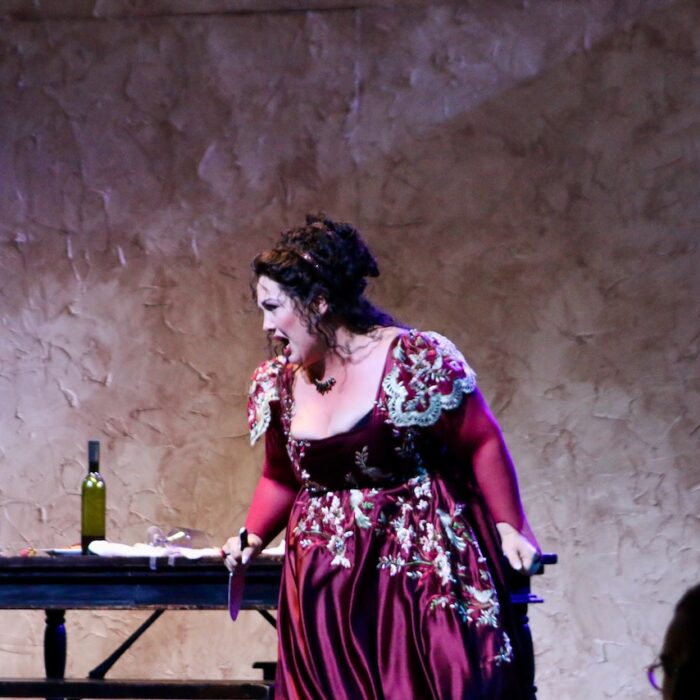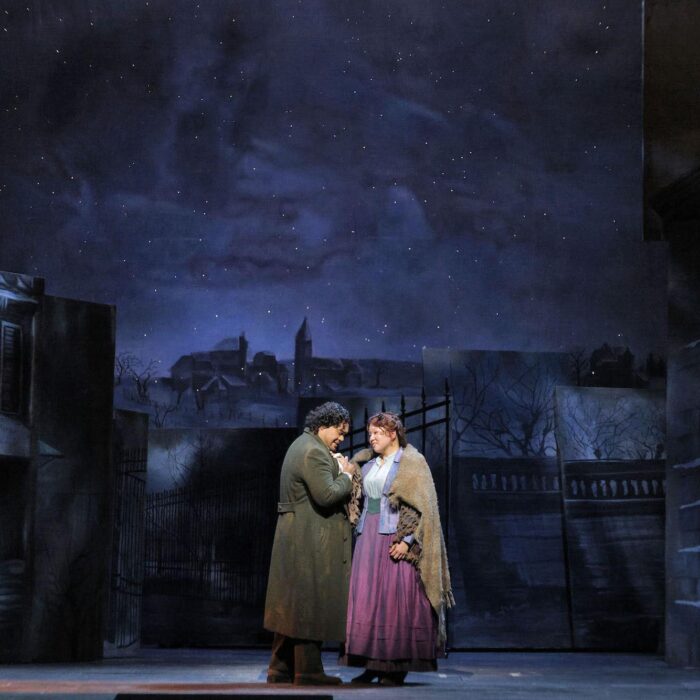
Teatro alla Scala 2024-25 Review: Il nome della rosa (World Premiere)
By Bernardo Gaitan(Ph. Brescia – Amisano © Teatro alla Scala)
In a suitcase–acquired expressly to transport it due to its weight and size–travels, rehearsal after rehearsal and performance after performance, the score of “Il nome della rosa,” weighing an impressive 15 kilograms. Yet the heft of this voluminous tome is not merely physical but also semiotic: it is the fruit of the mind of Italian composer Francesco Filidei, who devoted four years to composing this monumental opera of nearly three hours of music, conceived specifically for its world premiere at Teatro alla Scala under the management of Dominique Meyer.
Filidei, born in Pisa in 1973 and currently based in Paris, has been published by Casa Ricordi since 2018 and was recognized by Classic Voice magazine as one of the ten most intriguing composers on today’s international scene. After witnessing the world premiere of his fifth opera, one can only agree. In addition to composing the music, the Tuscan composer participated in the creation of the libretto alongside Stefano Busellato, with contributions from Hannah Dübgen and Carlo Pernigotti. Drawing from Umberto Eco’s 1980 novel of the same name –which musicologist Raffaele Mellace describes as “the manifesto novel of postmodernism”–they crafted an extraordinary adaptation. Some characters were removed and many narrative situations simplified to avoid, as the composer himself humorously explains in the program notes, “not being Stockhausen or suffering from acute Wagneritis, I didn’t want to write a 20-hour-long opera.” The dramaturgical team’s language is clear and concise, predominantly in Italian, with numerous ecclesiastical phrases rigorously in Latin and some insertions in German, Ancient Greek, and French.
Filidei’s score is astonishingly inventive, ingenious, and as anticipated, profoundly semiotic: imbued with signs and symbols that reach far deeper than what is immediately perceptible on the surface. His orchestration, enriched with onomatopoeic effects and unconventional sounds, immerses the listener in the monastic and mysterious atmosphere of an abbey where various crimes unfold. From the pit, in addition to the traditional orchestral instruments, a vast array of percussion can be heard. Each time a noun is mentioned, Filidei strove to faithfully reproduce its sound: wind is evoked with thick strings, horses with crotales, birds with wind instruments. Furthermore, unusual objects are employed: balloons, cutlery, newspapers, pieces of wood, books being struck together, sheets of paper torn apart, and a long list beyond.
The work is rigorously structured. The plot unfolds over the course of a week: the first three days in the first act and the last four days in the second one. Both acts are divided into twenty-four “strophes,” each centered on a specific note of the chromatic scale, creating a sonic journey that evokes both the form of a rose and a labyrinth–central symbols in Eco’s work. Filidei intertwines Gregorian melodies and dissonances, crafting a musical fabric that oscillates between the sacred (with contemporary touches) and the profane.
The complexity of the score found its ideal interpreter in Ingo Metzmacher, who conducted the Orchestra of Teatro alla Scala with precision, rigor, and sensitivity. The German conductor’s reading highlighted every timbre and dynamic nuance, delivering a cohesive and captivating interpretation that exalted the richness of Filidei’s writing, always carefully balancing dynamics and volume to avoid overshadowing the singers. The Teatro alla Scala Chorus, directed by Alberto Malazzi and Giorgio Martano, along with the Children’s Choir led by Bruno Casoni, were positioned high above, as if in a cathedral. The chorus plays a vital role, acting as the collective voice of the abbey and contributing to a solemn and contemplative atmosphere.
For this world premiere, an international cast of the highest caliber was assembled, demonstrating exceptional virtuosity in tackling contemporary music; curiously, the two leading roles were not assigned to Italian singers, but to American ones. Kate Lindsey portrayed the young monk Adso da Melk with vibrant skill. Possessing a clear and agile voice in the upper register and a polished tone in the middle and lower range, the mezzo-soprano effectively conveyed both the vocal and dramatic concerns of the innocent novice. Her only slight weakness was the occasional giveaway of her Anglophone pronunciation. Lucas Meachem delivered an authoritative and incisive portrayal of the learned Franciscan monk Guglielmo de Baskerville. With a homogeneous and enveloping voice, bright in timbre, the baritone crafted a noble and austere character, mastering phrasing with elegance and charisma, supported by impeccable pronunciation and a beautiful line of singing.
Bass Gianluca Buratto brought to life the unsettling and malevolent blind monk Jorge da Burgos with a deep, dark, and expressive voice that added solemnity and drama to the sinister character. Meanwhile, baritone Roberto Frontali stood out as the deformed monk Salvatore, with a lively and proactive interpretation, supported by a rich timbre and nuanced acting. Tenor Giorgio Berrugi offered a charismatic interpretation of the monk-steward Remigio da Varagine, with a resonant voice and refined vocal line.
Soprano Katrina Galka charmed in her double role as the village girl and the statue of the Virgin, with a clean and agile instrument that evoked Gregorian chants with elegant musicality. Daniela Barcellona performed in travesti as the cruel inquisitor Bernardo Gui; the mezzo-soprano showcased a spherical and masculine voice, with musical intelligence, crafting a sharp and menacing villain. Bass Fabrizio Beggi offered a solid and solemn Abbone da Fossanova, the library assistant, while countertenor Carlo Vistoli shone in the roles of Berengario da Arundel and Adelmo da Otranto–both murdered monks–thanks to his versatility, clear pronunciation, and strong acting. Paolo Antognetti effectively portrayed the herbalist Severino da Sant’Emmerano, while Leonardo Cortellazzi stood out as Venanzio and Giovanni Alborea, with a luminous and brilliant vocality.
The staging was marked by a visually impactful design achieved with few but highly symbolic elements, the result of the ingenuity of the internationally acclaimed Damiano Michieletto. The stage was populated by fantastic and grotesque creatures evoking Renaissance iconography. Dominating the scene was a dark gallery housing the choir, a luminous cross that ignites at the opera’s conclusion, and a complex labyrinthine structure of suspended transparent white veils–an allusion to the investigative enigma.
Among Paolo Fantin’s scenic elements, notable features include a pool of blood with a submerged body and a wall covered in scorpions for the monks’ deaths. Fabio Barettin’s powerful lighting contributed to the strong theatrical impact. Among the most memorable sequences Michieletto offers are a goat playing the violin, processions of colorful animals, the scene of Adso curled up in a giant statue of the Virgin, the blind monk’s suicide as he devours the poisoned pages, and the Apocalypse portal from which naked bodies emerge, all accompanied by choreography from Erika Rombaldoni. Although Michieletto’s scenic approach is minimalist and contemporary, Carla Teti’s costumes strongly evoke the Middle Ages: the Roman designer presents splendid religious garments in various medieval colors.
At the end of the performance, there were great ovations for all the performers and especially for the composer, who was present in the theater to witness the success of his project. The opera concludes with an ostinato sung by the children’s choir, intoning the final phrase that Eco includes at the end of his novel: Stat rosa pristina nomine, nomina nuda tenemus; which translated means “The primordial rose exists only in name; we possess only bare names.” A phrase suggesting that the essence of things can be identified through their name, while their tangible form may shift or vanish over time.



